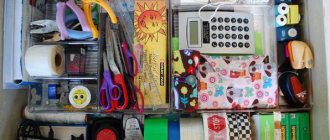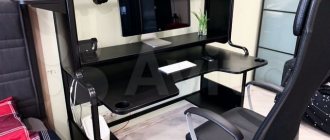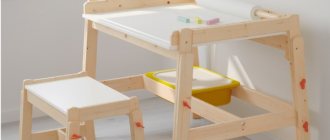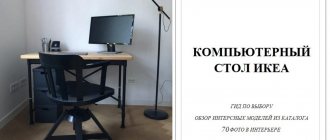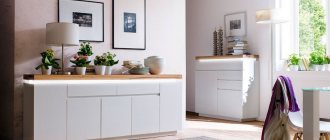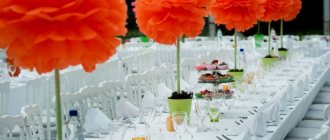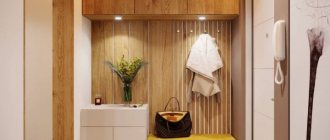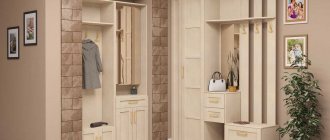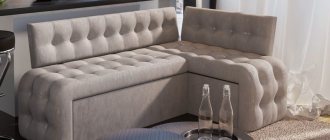Follow the principle: first the necessary, then the beautiful
Arrange things according to the principle - first the necessary, then the beautiful.
Putting a photo frame or a cactus in a stylish pot on your desk is nice, but it doesn't make sense if your workspace isn't comfortable. The first place to start is with yourself and your routine. If you are a journalist and always write out plans for future materials on sticky notes that you place around, you need a spacious work desk with a pen and sticky notes at hand, and it’s better to put scissors, tape and paper clips in a distant drawer. Or if at work you have to read a lot of documents, then the first thing you need to take care of is an additional lamp. Maybe there just isn’t enough space for it because of the beautiful succulent.
Children's workplace for a girl on the right by the window
Types of desks at an angle for a computer
Types are left-sided and right-sided. The structure can be installed both on the left side of the room and on the right, regardless of whether it is for a left-handed person or a right-handed person.
- Left-handed. This type is more suitable for left-handers; the main working side will be located on the left.
- Right-handed. This view is for right-handers; the working surface will accordingly be on the right.
Take care of the ergonomics of your home office
Types of storing items on your desktop
The “arm's length” rule is a basic rule for any workspace. Place furniture (stands, cabinets) and accessories (organizers, folders) that you use every day at arm's length. Everything else is further away.
Rules for an ergonomic home office
There are three types of storage of documents and items in the workplace:
- Tabletop, i.e. on the table - something that is needed every day several times, for example, pens.
- Above the table, that is, on the wall shelves opposite the table - something that is needed several times a week, for example, printer paper (place the shelves no higher than 40 cm, otherwise you will have to get up every time).
- Under-table, i.e. under the table - something that is needed once a week or less, for example, a new pack of paper clips.
Anything that doesn’t fit into these storage levels is best hidden away or even put away in the pantry.
Keep everything you need for daily work within arm's reach.
Ergonomic workplace standards: table
Four principles of ergonomics in any space: safety of movement, convenience and comfort. If you follow the workplace ergonomic standards in the table below, your knees won't hit your desk. And you can get a stack of paper from the top shelf while sitting on a chair. Such little things increase work efficiency by 30 percent.
| Furniture | Standards |
| Desk area | minimum 120 cm |
| Desk depth | maximum 80 cm |
| Desk height (from floor to tabletop) | minimum 72 cm |
| Height of footwell under table | minimum 60 cm |
| Width of legroom under table | minimum 50 cm |
| Depth of space under the table (at knee level) | minimum 40 cm |
| Depth/width of chair surface | minimum 40 cm |
| Seat height | from 40 to 55 cm |
| Arm's length distance (for important accessories) | from 50 to 60 cm |
| Height of the shelf above the table (so as not to get up) | from 38 to 40 cm |
| Distance from eyes to monitor | minimum 40 cm, ideally 60–70 cm |
Infographics ergonomics of workspace at home
Compliance with ergonomic rules in the workplace will increase work efficiency by 30%.
Workspace lighting
Lighting depends on the type of activity: for a seamstress - main lighting + two additional lamps, for reading documents - main lighting + one lamp, and if all the work takes place on a monitor screen, then general lighting may be enough.
Table lamp on the desktop rules for lighting the workspace
The standard option for lighting a workplace is diffused ceiling lighting + a lamp on the desktop with a light 2–3 times brighter than the ceiling. If the desktop is hidden in a niche, then a couple of additional sconces should be provided.
IMPORTANT: When choosing a place for a table lamp, remember that the light should fall from the left side if you write with your right hand and from the right side if you write with your left. This way there will be no shadow from the hand.
An example of placing a lamp on the desktop on the left side for right-handers
As for lamps, it is better to focus on LED lamps and lamps. They do not use as much electricity as incandescent lamps and do not get as hot as halogen lamps.
TIP: It is best for all Light Sources to have approximately the same color temperature. We talked about this in more detail in our material about lighting.
The ideal lighting for the workplace is diffused ceiling lighting + a table lamp with a light 2–3 times brighter than the ceiling.
Desk and window
Most people tend to place their desktop parallel to the window. This is not a bad option, but curtains or blinds are definitely needed here. Thus, it will be easier to control the intensity of daylight and the strain on the eyes will not be so great. But you definitely shouldn’t sit with your back to the window. In this case, a shadow will appear that will interfere with your work. Ideally, place the table to the right or left of the window.
| GOOD EXAMPLE | BAD EXAMPLE |
Workplace parallel to the window with blinds
Workplace parallel to the window without blinds example
| GOOD EXAMPLE | BAD EXAMPLE |
Desktop to the left of the window
Desk with your back to the window
How to set up a desk for multiple users?
When setting up tables for multiple users, it is worth considering not only their location relative to the light and door, but also from the point of view of interpersonal relationships. It is an unfavorable situation when people are forced to sit back to back. On the other hand, if they are sitting face to face, the distance should be at least 120 cm.
Placing a desk directly next to a window has its advantages. You can relax by taking a break from work to watch the street. If there is a lot of greenery in the yard, then the landscape looks simply irresistible.
Don't give up your desk even in a small apartment
If there is no room for a full-fledged desktop, use corners, niches, balconies, secret folding tables, or all together, and let the cabinets be on wheels
An example of a home corner workplace in a small apartment
Home office on the balcony in the corner
There are corners everywhere, and corner tables are considered the most comfortable.
Small home office on a balcony in the corner
Hidden Folding Desk
For such a workspace, you only need a wall, and a chair can be pulled up from the dining table if there is absolutely no space.
Hidden desk on the wall placement example
Budget desktop made from an old countertop
Take a tabletop (for example, a former door from a cabinet in the kitchen) and legs, connect the parts together and place them on the floor or attach them to the wall, so you get a wall table. In any case, there is enough space for a laptop.
Small budget desk hanging from the wall example
Workspace in a niche
A workspace under a sloping wall in a niche is common in two-story apartments or attic apartments.
Home workplace in a niche under a sloping ceiling
Desk on the windowsill
Make the window sill longer and deeper, and your workspace is ready. If the window sill is high, use a special bar work stool. More options for using a window sill as a work area or for relaxation in the article.
Workplace on the windowsill in the apartment
Recommendations for selection
Choose a corner computer desk based on the size of the room in which you plan to install it.
- Carefully consider the design of the corner table, its height and width. It should be easy to use and fit your size.
- The color of the structure can be matched to the rest of the furniture in the room, or it may differ from it. When choosing, rely on your taste and preferences.
- Choose the material based on the functionality of the installed structure and the purpose of the room in which installation is planned.
- Consider organizing additional space for storing office supplies or installing a system unit. These could be lockers, add-ons, or even a pencil case.
Now you can decorate your workplace
Plants in the home office
Flowers and aquariums are a great option if you need to relax for a while while working. Sansevieria is suitable for a spacious workplace. It copes with low humidity, does not require spraying and is content only with regular wiping of the leaves. Small workspaces benefit from low-maintenance cacti and succulents.
Also about plants it will be interesting:
Cacti in the interior: how to choose a suitable prickly friend
Living grass and plants in the interior: 12 fun ideas
Pampas grass in the interior of an apartment, cottage and more: 53 decor options
Sansevieria flower for a spacious desktop at home
Succulent on a small desktop for the apartment
Wall for notes opposite the desktop
In order not to spoil the wall opposite the table by sticking photos, posters, etc. on it, it is better to fix a cork board on the wall (if you like pushpins), a board with a slate coating (write with chalk), a metal mesh (mainly for photos) or A creative option (and the most budget-friendly) is to cover the frame with textiles and leave stickers/photos/notes on it. You can install such boards directly in front of the table, or, if the table is equipped between two walls, then use the wall on the right or left.
Cork wall for notes to the left of the desk in the apartment
Cork wall for notes opposite the desk in the apartment
Wall with slate covering for notes opposite the desk in the apartment
Metal mesh for notes and photos opposite the desktop in the apartment
Decorative frame for notes and stationery opposite the desktop
Decorative frame for notes and stationery opposite the desk in the apartment
Drawers at the desktop
To save space on or near your desktop, and not crowd everything around with drawers, use an organizer panel or, in other words, a pegboard. In fact, it is a perforated wall panel with holes. You can hang everything you need in these holes using a hook.
Perforated panel with holes opposite the workplace for storing office supplies
Hidden sockets
Once you remove a couple of wires, your workspace becomes tidier. For example, you can hide sockets in a drawer near your desk. Firstly, it is more convenient than under the table. And secondly, it looks neat.
Hidden sockets in a cabinet drawer
There are also simply decorative techniques to hide wires and sockets. For example, disguise the wire from a table lamp behind the leg of a desktop or make an installation out of wires.
An example of decorating wires in an apartment
Hidden socket under the table in a basket attached to the tabletop
Organizer frame
To make the decorative frame practical, sew several pockets for stationery into it.
Aged frame opposite the desk in a country home office
Desk organizer in the form of a frame
Desk organizer in the form of a frame
What kind of material is there?
Stores provide a large selection of materials. When choosing, you should rely on practicality and wear resistance. Pay attention to the type of material; it can complement the overall concept of the apartment or become an accent in your interior.
Material options:
- Glass.
- Tree.
- Metal.
- Chipboard/chipboard.
- MDF.
The most expensive material is wood. The price will increase if the design is made to order. An alternative could be laminated chipboard/chipboard/MDF. These materials are practical and have a wide color palette.
The gloss from glass looks unusual in the interior; this material is practical from a cleaning point of view and does not absorb liquids. To order, you can make a design of any shape and color, adding photo printing or stained glass decor. The metal one will last for many years, it is difficult to break or spoil it.
